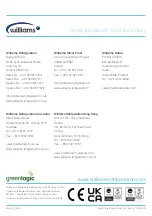
12
APPLIANCE ROUTINE MAINTENANCE / CLEANING
ROUTINE MAINTENANCE
Safely disconnect the appliance from the
power supply before cleaning, servicing or
undertaking general maintenance.
We recommend that you undertake regular
preventative maintenance using a qualified
service provider in order to get the best from your
equipment.
Ensure you check the sealant between panels on
an annual basis and clean and replace the sealant if
required as damaged sealant can affect the hygiene,
performance and efficiency of your equipment.
CLEANING
Always wear appropriate personal protective
equipment (PPE) when cleaning the appliance. Care
should be taken for parts with possible sharp edges.
Stainless steel is naturally corrosion-proof and
needs no additional protective coating to maintain
its gloss and usability for a long time.
Abrasive or corrosive cleaning agents should never
be used. These can damage surfaces and cause
corrosion. They include:
• Cleaners containing chloride;
• Bleaches containing hypochlorite (if accidentally
spilled on stainless steel, rinse off with water
immediately and thoroughly);
• Silver polish
If the cabinet exterior is looked after correctly it will
retain an “as new” finish for many years. A damp
cloth is usually sufficient for wiping away light dirt,
food debris and finger marks and normal day to day
cleaning should be carried out with a soft cloth and
soapy water.
White PVC coated panels are more durable, but still
should be cleaned with a soft cloth and soapy water.
Dry thoroughly afterwards and where possible
remove all racking, shelving and drawer fittings to
aid the process.
Kitchen fats, oil and greases can also cause brown
spots or stainng to appear on the stainless steel
surface.
For stainless steel with visible polishing grains,
clean the steel with the grain - not against the grain.
When water has been used for leaning or rinsing,
wipe the surface dry to prevent water from drying
and forming watermarks, especially in areas with
hard water. Avoid this type of watermark by using
distilled water.
For tougher spots, creamy polishes like CIF original
cream can be effective. Light pressure should be
used when cleaning with the grain. The cleaning
process should be repeated in order to prevent any
dirt becoming lodged in the surface grain again.
CIF original cream cleaner can also be used
for wiping off water spots and can alleviate
discoloration. Remove this type of residue by rinsing
with clean, preferably distilled water and wipe away
any remaining streaks of polish or watermarks.
Tough grease or oil marks can also be removed
using denatured alcohol or acetone. There is no risk
of corroding stainless steel by using such solvents.
For ease of use limit the amount of solvent used.
Wash more than once using a pure solvent on a
clean soft rag until all traces of the greasy residue
are removed.
Specialist Stainless Steel Cleaners - Non food
contact surfaces only
Innosoft B570 is a special deep cleaner that is
suitable for the intensive cleaning of contaminated
stainless steel surfaces, and removes stains and
oxides in a single operation.
Innoclean B580 completely removes any residues
left after the use of Innosoft B570 and passivates
the surface which helps to prevent further
corrosion.
APPLIANCE ROUTINE MAINTENANCE / CLEANING






































